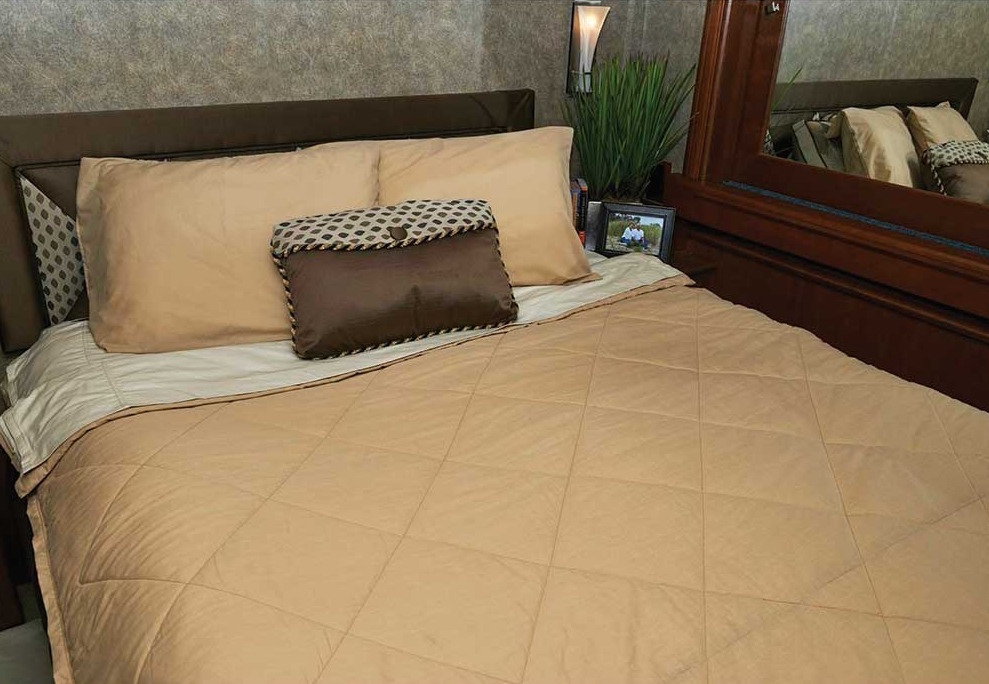
HOW did you sleep last night?
This isn't a story of if you got a good night's sleep, but how you did. Now for all you RVers who have walk-around beds that are easy to make, maybe we can have a discussion some other time on thread count and percale quality. However, if you're a Class B or Class C owner (or maybe even an A with a hard to make bed), this article's for you.
When we bought our first Navion we had a floorplan with narrow twin beds. Being our first motorhome we were pretty "old school" and found narrow fitted sheets for bunk beds on Amazon that fit perfectly. However, before we even put the sheets on, we stretched a similarly smaller sized mattress cover over the foam bed cushions.
Because the bed cushions were essentially wrapped by walls on all three sides, to stretch the cover and fitted sheets, we'd lift up the entire mattress and then, in the hallway, wrestle the sheets on. With the mattresses back in place we'd lean over and tuck a blanket in on the wall side. That wasn't fun either.
The whole process was, well --, rather tedious. My wife Terry was the first to eschew an evening between the sheets and took to sleeping on top of the blanket on the bed with a cozy and soft Kanata throw pulled over her. I clung to tradition for a couple of trips and then finally followed her lead. Sleeping under a throw turned out to be pretty comfortable and, as I've queried many other RVers, this seems like a common bedding solution.
Shortly before we took delivery of our new Navion, I started thinking about bed linen solutions. We were going from twin style beds to more of a full-sized (almost queen) mattress. It's a corner mattress and our past experience told me that it would be impossible to make it up as a regular bed. A traditional sleeping bag got ruled out as they are too big and bulky, hard to regulate temperature, and a hassle to wash. Using the throws was a proven solution, but, with some degree of partial disclosure, I'll admit that I'm not a PJ kind of guy and sleep more comfortably in skivvies, so I still liked the idea of sheets.
Further web research and even a few YouTube videos pointed me in the direction of a quilt-like product that zips on the sides and bottom like a sleeping bag. However, the "sack" has Velcro tape that runs down both sides where a double length sheet is attached and, when you fold the sack back up, the sheet is now held in place and doubled over at the correct length.
After a week or so you un-Velcro the sheet and pop it and the pillowcases in the laundry. When the double length sheet is clean and dry, you'll spend about five minutes affixing the sheet to the sack. The sack itself is quilted and for cold nights you flip it so the heavier side is on top and the lighter on the bottom. Simply reverse if the climate gets warmer.
After a couple of weeks on the road with the new sleeping arrangements, Terry volunteered that she thought it was a very good system. And I too give it a big thumbs up.
But, convenience comes with a price. The RV Superbag is now the only product like this on the market and a queen comforter with sheets runs $290. With the RV Superbag you have the option of multiple colors and upscale high-threadcount 100% cotton sheets (I'm lookin' at you - Prevost owners!). The design of the Superbag elegantly address the challenges of making an RV bed, yet also offer the same sleep comfort we have at home.
So tonight, here in the Florida Keys, after two weeks of sleeping between the sheets it's time to turn in and, I'm happy to say, will do so quite comfortably.
Comments
Comments on this post are moderated, so they will not appear instantly. All relevant questions and helpful notes are welcome! If you have a service inquiry or question related to your RV, please reach out to the customer care team directly using the phone numbers or contact form on this page .
